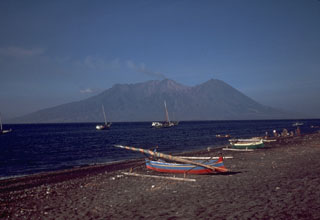Report on Sangeang Api (Indonesia) — 12 June-18 June 2013
Smithsonian Institution / US Geological Survey
Weekly Volcanic Activity Report, 12 June-18 June 2013
Managing Editor: Sally Sennert.
Please cite this report as:
Global Volcanism Program, 2013. Report on Sangeang Api (Indonesia) (Sennert, S, ed.). Weekly Volcanic Activity Report, 12 June-18 June 2013. Smithsonian Institution and US Geological Survey.
Sangeang Api
Indonesia
8.2°S, 119.07°E; summit elev. 1912 m
All times are local (unless otherwise noted)
CVGHM reported that during May through 13 June diffuse white plumes rose 10 m above Sangeang Api's crater. Both the lava dome and surrounding areas showed no changes since November 2012. The Alert Level had been increased to 3 (on a scale of 1-4) on 19 May due to a trend of increasing seismicity; as many as 77 shallow earthquakes and 66 deep earthquakes had been detected daily. Residents and tourists were advised to stay away from the craters within a radius of 5 km. Since then seismicity decreased; 15 shallow earthquakes and three deep earthquakes were recorded on 13 June. The Alert Level was lowered to 2 on 14 June. The public were advised not to approach the craters within a radius of 1.5 km.
Geological Summary. Sangeang Api volcano, one of the most active in the Lesser Sunda Islands, forms a small 13-km-wide island off the NE coast of Sumbawa Island. Two large trachybasaltic-to-tranchyandesitic volcanic cones, Doro Api and Doro Mantoi, were constructed in the center and on the eastern rim, respectively, of an older, largely obscured caldera. Flank vents occur on the south side of Doro Mantoi and near the northern coast. Intermittent eruptions have been recorded since 1512, most of them during in the 20th century.
Source: Pusat Vulkanologi dan Mitigasi Bencana Geologi (PVMBG, also known as CVGHM)

